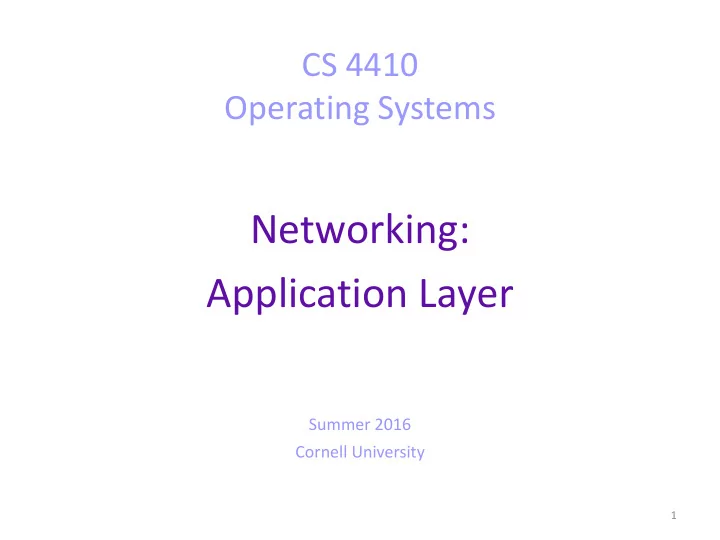

CS 4410 Operating Systems Networking: Application Layer Summer 2016 Cornell University 1
Today • Two application-layer protocols: – DNS – HTTP
Domain Name Service When a user wants to communicate with a remote node, is it easier to remember 69.63.176.13 or ● www.facebook.com? Human-friendly names are given to nodes. ● Simultaneously, a translation mechanism should exist between names and IP addresses. ● Packets need IP addresses to be transmitted. ● Will we use arbitrary or well-structured names? Why? ● It affects the efficiency of the translation mechanism. ● Nowadays, we use Domain Names. ● Well-structured strings. ● Multiple labels separated by dots. ● They create a hierarchical Domain Name Space. ● Use: ● Emails, web sites ● 3
DNS root com uk org edu cornell harvard cs ece mae Hierarchical Domain Space ● Every domain name should belong to this tree. ● When a process wants to send data to www.facebook.com, somebody needs to provide the IP ● translation. Who? Domain Name Service (DNS) ● 4
DNS ● Can we have only one server in the network which would provide the translations of all domain names? Why? ● DNS uses multiple DNS resolvers (servers) in the network and the translations are distributed among them. How? ● Each DNS resolver is responsible for a subset of the Domain Name space. 5
DNS Example: ● Suppose we want to access www.cs.cornell.edu. ● First, the DNS resolver in the OS contacts root DNS server and asks if it knows the translation ● of www.cs.cornell.edu. The root does not know the translation, but it knows the DNS server that is responsible for ● .edu addresses. Thus, it forwards the request there. The DNS server for .edu does not know the translation, but it knows the DNS server ● responsible for the cornell.edu addresses. Thus, it forwards the request there. The DNS server for cornell.edu does not know the translation, but it knows the DNS server ● responsible for the cs.cornell.edu addresses. Thus, it forwards the request there. Finally, the DNS server for cs.cornell.edu addresses sends the IP address of the wed site ● www.cs.cornell.edu. Improvement: ● One or more of these DNS servers may have cached the translation from previous requests, ● accelerating the DNS query. 6
HTTP • HyperText Transfer Protocol – The Web’s applications -layer protocol. • https://studentessentials.cornell.edu/ • HTTP defines how Web clients request Web pages from Web servers and how servers transfer Web pages to clients. • HTTP uses TCP as its underlying transport protocol.
HTTP • A user requests a Web page. • The browser sends HTTP requests messages for the objects in the page to the server. • The server receives the requests and responds with HTTP response messages that contain the objects.
HTTP
HTTP • Request Message: • Response Message: GET /somedir/page.html HTTP/1.1 HTTP/1.1 200 OK Host: www.someschool.edu Connection: close Connection: close Date: Thu, 07 Jul 2007 User-agent: Mozilla/4.0 12:00:15 GMT Accept-language: en Server: Apache/1.3.0 Last-Modified: Thu, 07 Jul 2007 12:00:15 GMT Content-Length: 6821 Content-Type: text/html (data data ... data)
End-to-End Argument Should the network guarantee packet delivery? ● Think about a file transfer program. ● Read file from disk, send it, the receiver reads packets and writes them to the ● disk. If the network guaranteed packet delivery, one might think that ● the applications would be simpler No need to worry about retransmits. ● But still need to check that the file was written to the remote disk intact. ● A check is necessary if nodes can fail ● Consequently, applications need to be written to perform their own retransmits. ● No need to burden the internals of the network with properties that can, and ● must, be implemented at the periphery. 11
End-to-End Argument ● Application-specific properties are best provided by the applications, not the network. Guaranteed, or ordered, packet delivery, duplicate suppression, security, etc. ● ● The Internet performs the simplest packet routing and delivery service it can. Packets are sent on a best-effort basis. ● Higher-level applications do the rest. ● 12
Today • Two application-layer protocols: – DNS – HTTP
Coming up… • Next lecture: Security 14
Recommend
More recommend